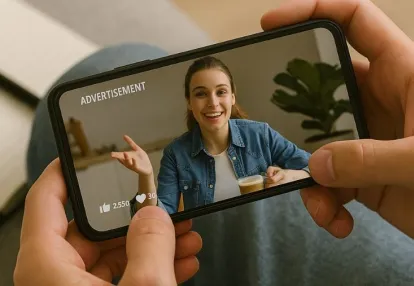
Our spy tools monitor millions of TikTok ads from over 55+ countries. Biggest TikTok Ad Library in E-commerce and Mobile Apps!
Try It FREETikTok has quickly become a popular platform for both content creators and advertisers, thanks to its unique short videos. However, the constant stream of ads can sometimes disrupt the seamless user experience that TikTok is known for. This has led to the idea of TikTok Ad Free, which aims to provide an ad-free version of TikTok to enhance user experience by eliminating ad interruptions.
The concept of using TikTok without ads goes beyond just uninterrupted browsing; it also involves protecting user privacy. You see, most ads rely on gathering and analyzing user data for targeted advertising, which raises concerns about privacy violations.
To address these concerns and improve user experience, TikTok has recently introduced a paid subscription option that promises an ad-free environment. But here's the thing: Can we actually enjoy TikTok without ads? And if so, how can we do it?
In this article, we will explore these questions in detail. We'll discuss various methods to achieve an ad-free TikTok experience - from adjusting in-app settings to using third-party ad-blockers. We'll also analyze the impact of the new paid subscription model on TikTok's revenue streams.
Mastering TikTok Dropshipping provides further insights into how marketers are adapting their strategies in response to these changes. This includes leveraging TikTok's massive user base and exploring the potential of dropshipping on the platform.
TikTok has introduced an ad-free version to its platform, providing users with the option to browse content without interruptions from advertisements. This subscription offering is a significant shift from TikTok's standard ad-supported model and represents a pivotal moment for user experience on the app. Here's what you should know:
The new ad-free tier allows users to enjoy TikTok without the usual commercial breaks. For a monthly fee, reportedly at $4.99, subscribers can navigate through videos seamlessly, which could be particularly appealing to those who use the app extensively.
The decision by TikTok to launch a paid subscription model is part of a broader strategy to diversify its revenue streams. With this move, TikTok joins several other platforms in offering premium versions of their services, targeting users willing to pay for enhanced experiences.
Social media platforms are increasingly scrutinized under EU digital privacy regulations such as GDPR and the upcoming Digital Services Act. By providing an ad-free subscription, TikTok might be positioning itself to better align with these regulations that demand higher standards of user privacy and data protection. This offering could reduce reliance on targeted advertising that necessitates extensive data collection.
By integrating this subscription model, TikTok acknowledges the evolving needs and preferences of its user base while potentially addressing regulatory pressures concerning digital privacy.
Experience the many advantages of an ad-free TikTok.
One major advantage is the elimination of interruptions. The essence of TikTok lies in its rapid, engaging content that keeps users hooked for hours. With ads popping up between videos, this rhythm gets disrupted, often leading to user frustration. An ad-free experience ensures a smooth scroll through your feed, allowing you to enjoy the content without any distractions.
Another significant benefit relates to user privacy. Ads rely heavily on user data for effective targeting. This means that while browsing through your feed, you are inadvertently sharing a lot of personal information with advertisers.
When you opt for an ad-free experience, this data collection process halts, providing a much-needed respite for privacy-conscious users. You continue enjoying your favorite content while maintaining control over how much information about you is out there.
TikTok's ad-free subscription offering provides these benefits and more, creating a seamless and private user experience that allows for uninterrupted enjoyment of the platform's diverse content.
Users have several strategies at their disposal to create an ad-free TikTok experience. It is essential to understand each method's intricacies to effectively reduce ad interruptions.
TikTok provides certain in-app settings that enable you to customize your preferences, potentially reducing the number of ads displayed:
Remember, these settings are designed primarily for user experience optimization and privacy protection rather than complete ad elimination.
For a more robust solution, you might consider third-party ad-blocking techniques. These tools typically work by filtering out advertising content from your feed:
It is crucial to select reputable ad blockers, as some may compromise privacy or functionality. Also, remember that using these tools may violate TikTok's terms of service, potentially affecting app performance or account status.
By adopting these methods, you can tailor your TikTok usage to be more comfortable and less invasive. However, the effectiveness and consequences of each approach should be carefully considered before implementation.
When it comes to ad-free options on popular social media platforms, a comparison reveals some key differences.
Facebook, for instance, does not offer an ad-free version as part of its revenue model. Instead, it relies heavily on targeted advertising based on user data. Despite occasional user requests for an ad-free subscription option, Facebook maintains its commitment to keeping the platform free for everyone.
On the other hand, Instagram, which is owned by Facebook, also does not provide an ad-free experience. Similar to Facebook, Instagram generates a significant portion of its revenue from ads that are personalized according to user data.
However, YouTube offers an ad-free experience through its premium subscription service. Subscribers can enjoy uninterrupted viewing, with the added benefits of offline playback and access to exclusive content.
Different monetization strategies come into play when traditional advertising is dismissed. YouTube Premium's monthly fee serves as a direct revenue source. Meanwhile, Instagram and Facebook lean towards partnerships with brands and sponsored content from influencers as indirect yet highly effective advertising strategies.
A close look at these platforms indicates that the introduction of ad-free options often goes hand-in-hand with alternative monetization strategies. This underscores the importance of striking a balance between maintaining user satisfaction and ensuring financial sustainability for these platforms.
TikTok's move towards an ad-free subscription model is a significant change in how it makes money. Up until now, like many other social media platforms, TikTok has relied heavily on advertising to generate revenue. So, it might seem strange at first for them to introduce a paid option that gets rid of ads. However, this decision actually shows that TikTok is trying to diversify its sources of income and not solely depend on ads.
Here are some potential benefits of TikTok introducing an ad-free subscription:
However, there are also some downsides to consider:
While exploring this new subscription model, TikTok is also looking at other ways to make money. One such initiative is the introduction of the 'TikTok Shop' feature, which allows users to shop directly from the app, making it easier for them to buy products they see on TikTok.
Here are some other ways TikTok is trying to generate revenue:
By exploring these different ways of making money, TikTok hopes to reduce its reliance on advertising revenue and create a more sustainable financial system. However, the success of these strategies depends on whether users and brands embrace them and if they can work alongside traditional advertising rather than replacing it completely.
When we talk about an ad-free TikTok, it's important to understand the role and impact of influencer marketing. Influencer marketing is when brands collaborate with popular creators to seamlessly integrate promotional content into their posts. These posts don't look like traditional ads, which raises questions about whether they would still be allowed in an ad-free subscription.
Currently, it seems that the ad-free subscription on TikTok only covers ads that are directly shown by the platform itself. This means that content from influencer marketing campaigns might still show up in users' feeds even if they have a paid subscription.
This difference matters because influencer marketing is a big part of TikTok. Influencers have millions of followers and get lots of engagement on their videos, so they can really help spread the word about brands and products. It's unlikely that this role as a promotional channel would be affected by an ad-free option.
However, there could be an impact on ByteDance's (the company that owns TikTok) involvement in influencer marketing. If regular users start switching to an ad-free experience, brands might choose to work directly with influencers instead of paying for ads on the platform. This change could affect how TikTok makes money and might require them to make some changes to their strategy.
But it's important to remember that these are just possibilities right now. As ByteDance continues to test and improve its ad-free offering, we should learn more about how influencer marketing fits into this new model.
In the next section, we'll look at some of the rules and business factors that could shape TikTok's future without ads.
TikTok is exploring the possibility of offering ad-free subscriptions, but there are many regulatory challenges to overcome. One important factor is the EU Digital Services Act, a set of rules designed to make the online world safer. These regulations place strict requirements on how social media platforms like TikTok handle user data and display advertisements. TikTok must find a way to comply with these rules while still making money from its ad-free model.
Complying with regulations is crucial for TikTok's long-term success. The EU Digital Services Act focuses on protecting user privacy, which is a top priority for many people. By following these rules, TikTok can build trust with its users and avoid any potential legal issues.
At the same time, TikTok needs to ensure that its ad-free model remains profitable. Offering an ad-free option means losing out on revenue from advertisers. To make up for this loss, TikTok will need to attract a large number of subscribers willing to pay for the service. This requires careful planning and execution to create a subscription plan that offers enough value to entice users.
Introducing an ad-free subscription tier could bring several advantages for TikTok:
As TikTok explores new avenues for monetization, it reflects a broader trend in the social media industry. Platforms are constantly adapting to meet the evolving needs and preferences of users.
The rise of ad-blocking software and increasing concerns about data privacy have led many platforms to explore alternative revenue models such as subscriptions or e-commerce partnerships. These approaches offer a way to generate income without solely relying on traditional advertising methods.
While the future of TikTok's ad-free model is uncertain, one thing is clear: social media platforms will continue to evolve as they navigate regulatory requirements and seek sustainable business models. As users, we can only observe how these changes unfold and impact our online experiences.
Is TikTok Ad Free Possible? How to Make It Happen? The answer is yes, and the choice ultimately lies in your hands. We encourage you to reflect on your own preferences and patterns of TikTok usage before making a decision.
The paid subscription offers an official route to an ad-free experience. However, bear in mind that there are alternative methods available with their own set of pros and cons. For instance, adjusting in-app settings or utilizing third-party ad blockers can also minimize ad disruptions.
Interestingly, even without opting for the ad-free version, you can still mitigate the impact of ads on your TikTok experience. Stay informed about your privacy settings and be selective with the accounts you follow.
Remember, your TikTok experience should be enjoyable and tailor-made for you. Making informed decisions about ads on the platform is a step towards creating this personalized experience.
Receive top converting landing pages in your inbox every week from us.
Must Read
User-generated content (UGC) is transforming the way brands connect with audiences through InStream ads. Learn how authentic, user-driven videos build trust, engagement, and stronger emotional connections. Discover best practices for integrating UGC seamlessly into your ad strategy to boost credibility and conversions. Ideal for marketers looking to create more genuine and relatable advertising experiences.
Rachel Thompson
7 minDec 12, 2025
Must Read
Short-form video ads are the key to grabbing attention in a fast-paced holiday market. Learn how to craft captivating, bite-sized videos that inspire action and boost conversions. Discover best practices for storytelling, platform selection, and creative optimization. Perfect for marketers aiming to engage holiday shoppers through dynamic, scroll-stopping content.
Rachel Thompson
7 minDec 4, 2025
Trending
Year-end campaigns don’t have to suffer from ad fatigue. Explore innovative ways to revive your marketing efforts with fresh creatives, updated messaging, and smarter targeting. Learn how to balance innovation with consistency to keep your audience engaged and conversions steady. Perfect for advertisers looking to finish the year with renewed energy and impactful results.
Dan Smith
7 minNov 27, 2025




